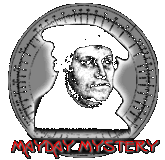
|
Delivery to my office 04.28.2003. Contents: Empty manilla with a small japanese (?) bag containing 1 coin, 1 small note, and 1 letter. I had a heads up about this in this email.
Contents: Note their tip o' the hat to Juls, who has been posting a ton of clues lately. Sorry, Juls, they pegged you as a 'he' :) Bag appears to be from the Kyoto Royal Hotel? That's the closese phone match I can come up with...
Ammon hooks up some Japanese help: Well... it's a shop in Kyoto. Founded in 1663, the store is called Kyukyodo which means something along the lines of 'House of Doves' (not a terribly accurate translation, but close enough). It apparently got the name because a lot of doves (the character could also mean pigeon, but I'm thinking dove) live(d) in the area. It looks like it started out as something of a drugstore, but eventually turned into something of a shop for finery... that might have served the imperial family (until 1942? not sure what the date is attached to without much more headache). I saw mention of incense and possibly jewellery. The bag itself... The big character means dove, and the 3 stylized characters at the bottom are the shop's name (dove being the first character there). The line above that is a list of their wares: perfume, something, something, japanese style writing tools, tea utensils. Juls: Just a wee tip for now (I just got up :-) ) Coin face one has the legend Qumran - you may already be aware, but just in case you're not, this is where the Dead Sea Scrolls were found. I'm not well up on coins, however, I think it's possible that this one could be a commemorative issue related to the discovery. A little background: the first of the Dead Sea Scrolls were found in Qumran, Palestine, in 1947, but the excavations were ongoing for years. Most of the thousands of fragments are still unpublished - an editorial team was apppointed in 1953 to decipher and edit and exercised a kind of monopoly over the material which has caused a lot of anger and resentment among archaeologists because they weren't getting the stuff published but were denying access to anyone else. Normal practice would have seen the publication of a regular series of interim reports. The monopoly was breached in 1991 and microfilm of all the texts, published and unpublished, was finally made available to scholars by an American library which had obtained a full set of negatives.http://amerisrael.com/article_historical_sites_01.html - Juls pegs the coin!! http://amerisrael.com/article_historical_sites_01.html There's a piccie of the coin at the bottom of the page and a good bit of what is probably highly relevant info, here's what I reckon.. The Essene community is probably one of the more significant factors linked to this coin, their apocalyptic tendencies tie in well with overarching themes in the announcements. There have been a few writings from the fringe about the Essene community and one of the ideas that have been put forward has been that the birth of Jesus as the Messiah was an event that was deliberately engineered by this community, ie. they saw to it that predicted occurrences took place surrounding the event and other requirement fulfilled that would legitimise it. Whether or not one takes that seriously, I do get a sense from these announcements of a community of people deliberately engineering an event of significance. Either way, the Essenes certainly had a very significant influence on Christianity and it seems likely that Jesus did have some connections with them. One other thing I should say, and I'm not too sure of this, I guess I should check it out, but I'm pretty sure that I recall something about the Catholic church exercising some form of control or influence over the team who were originally analysing the scrolls. Beacon(?) chimes in: http://www.kyoto-ipage.ne.jp/contents/kurasu/nakagyo.htm has the phone number under entry 00185 but the page is japaneese I think so I cant read it.
'Feducia cordis'
Ah! Good closeups! I think 5 sheckles form a 1982 series:
http://www.metalbox.net/hrobinso/coins/wcip98.html I note the codex has been referred to before also. The codex is the original bible of bound papayri. The books the papayri were bound into. The only reference to language per this is the mesopotamian Hammuraubi or the like. I have some info on that I can send on. RE letter: What "runes" does Orphanage refer to with respect to the 19 century quotation? I can also now understand how the Gaelic could be written the way it was. It is possible that they phonetically transcribed an Irish speaker rather than wrote it in Scottish. I look forward to thursdays clues.
Beacon: 04.30.2003 If you are looking into script languages there is a good directory here: http://www-oi.uchicago.edu/OI/IS/BRINKMAN/MesDir2003.pdf ...I am pursuing that line of inquiry presently. Click here to submit a clue for this page. |
